Credit Crisis Explained: History of Debt Bubbles and Long-term Interest Rates
Interest-Rates / Credit Crisis 2009 Jan 20, 2009 - 05:37 AM GMTBy: John_Mauldin

 There is a reason I call this column Outside the Box. I try to get material that forces us to think outside our normal comfort zones and challenges our common assumptions. And this week's letter from Hoisington Investment Management Company does just that. Let me give you two quotes to pique your interest: "Monetary policy works by creating the environment for a renewed borrowing and lending cycle. This cycle would require that the debt to GDP ratio, which is already at a record level, grow even higher. Would such an outcome really be that desirable when the controlling problem of the U.S. economy is too much improperly financed debt? If the Fed were able to engender an increase in the debt to GDP ratio, this might merely serve to postpone the reckoning of the current debt levels while laying the foundation for an even more vicious unwinding down the road.
There is a reason I call this column Outside the Box. I try to get material that forces us to think outside our normal comfort zones and challenges our common assumptions. And this week's letter from Hoisington Investment Management Company does just that. Let me give you two quotes to pique your interest: "Monetary policy works by creating the environment for a renewed borrowing and lending cycle. This cycle would require that the debt to GDP ratio, which is already at a record level, grow even higher. Would such an outcome really be that desirable when the controlling problem of the U.S. economy is too much improperly financed debt? If the Fed were able to engender an increase in the debt to GDP ratio, this might merely serve to postpone the reckoning of the current debt levels while laying the foundation for an even more vicious unwinding down the road.
And: "The only really viable option for federal stimulus is a permanent reduction in the marginal tax rates, as highlighted in the research of Christina Romer, incoming Chair of the Council of Economic Advisors. This would have the benefit of raising after tax rates of return, but the drawback in the short run of still having to be financed by an increased budget deficit. Over time, a massive reduction in marginal tax rates would be beneficial, but the operative word is time. Refunds, or transitory tax relief, will have no better results in stemming the recessionary tide in 2009 and 2010 than it did in the spring of 2008."
Van Hoisington and Dr. Lacy Hunt give us a seminar on the current bailout programs that is not the usual analysis we see in mainstream media. This week's letter requires you to think, but it will be worth the effort.
Hoisington Investment Management Company (www.hoisingtonmgt.com) is a registered investment advisor specializing in fixed income portfolios for large institutional clients. Located in Austin, Texas, the firm has over $4-billion under management, composed of corporate and public funds, foundations, endowments, Taft-Hartley funds, and insurance companies. And now let's jump right in to the essay.
John Mauldin, Editor
Outside the Box
THE GREAT EXPERIMENT
Quarterly Review and Outlook -- Fourth Quarter 2008
Hoisington Investment Management Company
The late Nobel Laureate, Milton Friedman, noted in his 1963 book, Monetary History of the United States (coauthored with Anna Swartz), that the money stock decreased by a massive 31% in the Great Depression. The turnover of that money, called velocity, fell 21%. Nominal GDP equals money multiplied by velocity. Consequently, from 1929 to 1933 the breakdown of both measures resulted in a contraction in nominal GDP of approximately 50%. However, Friedman postulated that if the Fed had not let money shrink, velocity would have been steady and the Great Depression would have been averted, i.e., nominal GDP would not have collapsed. Our current Fed Chairman, Ben Bernanke, is an expert on the Great Depression, and he has, in fact, adopted Friedman's strategy to greatly expand the money supply. Whether this prescription for economic stability will work in a period of over indebtedness, such as now exists in the U.S., is most uncertain. Indeed, this could be called the "great experiment" since this economic theory has yet to be thoroughly tested in the real world.
Presently, major sectors of the U.S. economy are experiencing a debt deflation that is causing a massive destruction of wealth, thereby curtailing jobs, income and spending. Irving Fisher who, according to Friedman, was the most brilliant of all U.S. economists has noted that when the economy enters a period of "debt and price disturbances", those forces will eventually engulf the economy. Fisher developed that concept by examining the 1929-33 depressionary period, as well as the depressions of 1837 and 1873, as examples of when excessive debt and subsequent price declines controlled "all or nearly all" other economic variables.
This theory of excessive debt and its pernicious and unrelenting deflationary impulse to the economy has been best chronicled by other notable economists: Charles P. Kindleberger (1910-2003), Hyman Minsky (1919-1996), Nikolai Kondratieff (1892-1938) and Joseph A. Schumpeter (1883-1950). Fisher contends that once extreme over indebtedness occurs, fiscal and monetary policy become impotent in spurring economic growth because money velocity will decline -- something that is currently happening. Individuals and businesses struggle to repay debt with harder dollars, and saving begins to rise as caution prevails.
The debt level of the U.S. has reached unprecedented proportions (Chart 1). More important than the level, however, is the fact that for the last few years the debt was improperly loaned and financed. In the words of the late economists Minsky and Kindelberger, this type of lending activity implies there is little likelihood of repayment of principal and interest. Stock prices have plunged, and with home prices plummeting, and commercial and industrial properties losing value, a deflation of assets has clearly begun while the underlying debt remains constant. Will this deflation overwhelm the best efforts of the Federal Reserve, invalidate Friedman's theory and prove Fisher correct?
Most naturally feel and hope that the superiority of unbridled monetary and fiscal stimulus will overwhelm incipient price declines and stem the expanding cyclical downturn in economic growth. Our judgment is that the power of monetary policy revolves around the ability to initiate a new borrowing and lending cycle. This can only happen if lenders are willing to lend and borrowers are wanting and able to borrow. Presently, neither are so inclined (Chart 2). If price declines in assets continue, then Shakespeare's admonition of "neither a borrower nor a lender be" will become the economic mantra, meaning that a period of very low nominal growth will likely extend for a decade. Moreover, fiscal policy actions may not be helpful either and could produce unintended negative consequences. Conventional wisdom is that the current economic contraction is nothing more than a typical post war recession. In the ensuing paragraphs we intend to frame an argument that is contrary to this conventional wisdom.
Chart 1
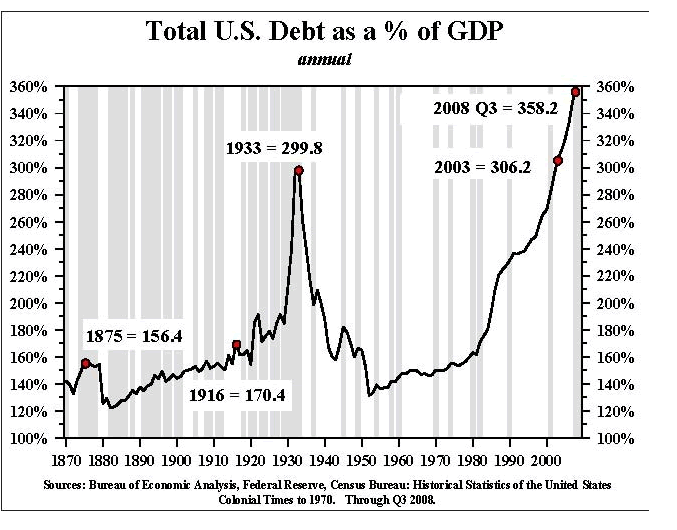
Chart 2
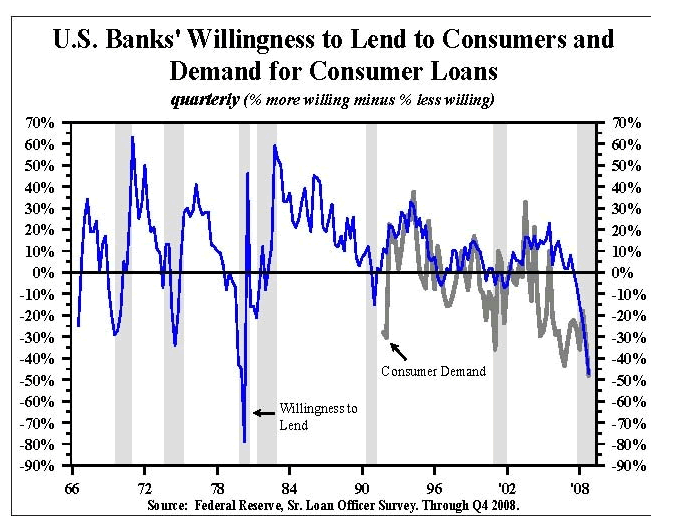
CAN FED POLICY CONTROL ECONOMIC DESTINY?
To respond to the country's severe economic problems the Fed has invented many new vehicles for injecting liquidity into the economy, but few outward signs suggest that these actions are engendering a recovery. Total reserves in the latest twelve months increased a record 1,897%. In the latest three months the M2 money stock jumped at an 18.2% annual rate, one of the largest quarterly increases on record. Many feel this is tantamount to the Fed printing money. However, nominal GDP is not equal to the stock of money but, as noted above, it is equal to the stock of money multiplied by its turnover, or velocity.
Friedman and Bernanke both believe that if the money supply is increased sufficiently velocity will stabilize and Fed actions will at least be able to keep nominal GDP stable or growing slightly. Fisher, on the other hand, argues that if a generalized debt deflation takes hold, velocity will decline, just as it did during the Great Depression.
Our analysis suggests that the Fed will not achieve the desired results of stable velocity. Velocity is a function of financial innovation, rising during periods of new innovations and falling when these innovations are reversed or unchanging. Fisher also suggested that velocity rises when leverage increases and falls when leverage abates. So far the evidence at hand suggests that velocity is thwarting the efforts of the Fed. In the fourth quarter velocity plummeted, completely offsetting the increase in M2. Thus, nominal GDP declined at a very rapid rate.
Monetary policy works by creating the environment for a renewed borrowing and lending cycle. This cycle would require that the debt to GDP ratio, which is already at a record level, grow even higher. Would such an outcome really be that desirable when the controlling problem of the U.S. economy is too much improperly financed debt? If the Fed were able to engender an increase in the debt to GDP ratio, this might merely serve to postpone the reckoning of the current debt levels while laying the foundation for an even more vicious unwinding down the road.
ARE MASSIVE FISCAL DEFICITS A CURE?
The major debate in Washington surrounds the issue of how large the fiscal stimulus should be. In this case, as in many such debates, the question being raised is probably not the right one. In 2008, the consensus opinion was that a stimulus program based on tax rebates and one time transitory payments would be sufficient to halt the recession. Discussions were based on the need to make such payments timely and targeted. Hardly any discussions were held in either official or non-official circles as to whether such a program was desirable. Had there been such discussions, the funds might not have been so badly wasted. Numerous studies had shown that consumers have a very limited tendency to spend transitory income, and that prior efforts to stimulate the economy through tax rebates had failed. Nevertheless, the political process barreled through with a program with no reasonable expectation that it would work. Now the economy is even deeper in recession and the country has an additional $177 billion in debt on which the taxpayers will pay interest in perpetuity. About 17% of the rebates were spent, a tad less than during the rebate program of 2001. The minimal spending response was exactly in line with the consumption functions under Friedman's permanent income hypothesis, as well as the equivalent Modigliani's life cycle hypothesis. These pioneering works demonstrated conclusively that consumers have a far greater tendency to spend permanent rather than transitory income.
Fiscal stimulus will not work well, and may even be counterproductive, and this applies to both spending programs and to certain tax programs as well. One of the major problems on the expenditure side is that the government sector is smaller than the private sector. In the third quarter, real government spending, including the federal defense and non-defense sectors, as well as the state and local sectors, totaled $2.1 trillion, comprising 17.8% of real GDP (Chart 3)
Chart 3

If there is a desire to increase government spending, the federal government must either increase taxes on the far larger private sector, an option that would presumably be precluded under the present circumstances, or borrow funds in the financial markets that would have gone to the private sector. At this point we have to ask which sector has the better track record of growing the economic pie—private or government expenditures? The private sector has demonstrated the greater flexibility and creativity to expand the economic pie, increasing productivity and thereby improving living standards for all. The risk is that increased federal borrowing will stunt the private sector's ability to grow.
The only really viable option for federal stimulus is a permanent reduction in the marginal tax rates, as highlighted in the research of Christina Romer, incoming Chair of the Council of Economic Advisors. This would have the benefit of raising after tax rates of return, but the drawback in the short run of still having to be financed by an increased budget deficit. Over time, a massive reduction in marginal tax rates would be beneficial, but the operative word is time. Refunds, or transitory tax relief, will have no better results in stemming the recessionary tide in 2009 and 2010 than it did in the spring of 2008.
An important offset to the increased spending by the federal sector is a massive cutback in state and local expenditures. If transfer payments are excluded from federal expenditures, the spending of state and local governments totaled $1.9 trillion in the third quarter, much greater than the $1.1 trillion spent by the federal government. Further, state and local governments employed 19.8 million workers versus 2.8 million for the federal sector. J.P. Morgan estimates that state and local governments will have a $400 billion shortfall in funding this year, an economic drag since balanced budgets are required in all but one of the fifty states. Thus, spending will be curtailed or taxes will rise.
MAJOR HEADWINDS FOR CONSUMER SPENDING
Consumer spending is contracting at a near record pace despite: (a) a strenuous effort by the Fed to loosen monetary conditions; (b) a $170 billion fiscal stimulus package that occurred in the second quarter of 2008; (c) the enactment of a troubled asset recovery program totaling $750 billion, and (d) promises for a major additional fiscal stimulus in 2009. These monetary and fiscal actions were overwhelmed primarily by an unprecedented decline in household wealth (Chart 4). Moreover, the wealth loss is now being augmented by significant job losses and a shorter work week.
Chart 4
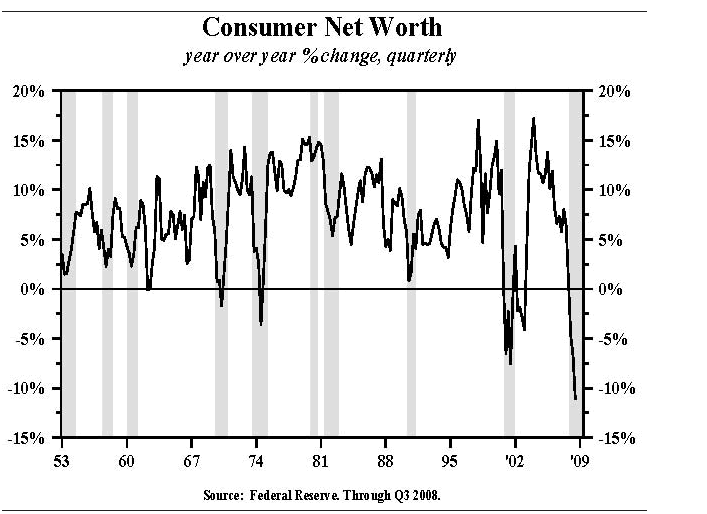
From the final quarter of 2006 through the third quarter of 2008, the real value of homes fell $3.5 trillion, while households' real holdings of stocks fell $2.1 trillion, resulting in a $5.6 trillion loss in total household wealth (Table 1). The wealth loss may exceed $10 trillion when the fourth quarter figures are tabulated. The Fed's econometric model indicates that a one dollar decline in real wealth will reduce total expenditures by 7.5 cents over three years. This means that the drag on consumer spending from declining wealth will be 3.4% per annum this year and for the next two years. By comparison, from 2000 to 2007 the annual increase in consumer spending was 2.9%. Additional losses in household income and wealth are likely in 2009.
Table 1
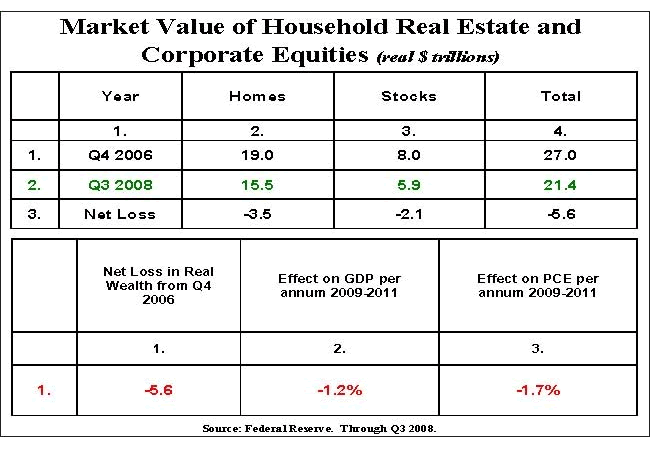
With consumers confronting such hostile wealth and income prospects, the saving rate is likely to rise sharply as it did after the Great Depression and, excluding the distortions created by World War II, continued to do for a half century. If the deflation now apparent in specific sectors of the economy spreads, the rise in the saving rate is likely to continue for a very long time. In the past, debt deflations have caused consumers to avoid at all cost the pattern of living beyond their means. Thus, the rising saving rate will constitute a major headwind for the U.S. economy.
GLOBAL IMPLICATIONS
As a percent of GDP, the trade deficit has fallen from 6% to 4.9% in nominal terms and 5.5% to 3% in real terms over the past two years. Real imports in constant dollars have declined by 3.5% in the latest four quarters, a dramatic reversal from the sharp increases of recent years. This drop in imports reflects the loss of consumer wealth and income, creating lower spending for imports, and this drag will persist for at least three more years. Therefore, further and even sharper declines in imports are likely. This will continue to transmit U.S. economic weakness to the rest of the world, while at the same time gradually and irregularly reducing the U.S. trade deficit.
Although the current account will narrow and fewer funds will recycle into the U.S., it is important to review the portfolios of foreign investors. Based on the latest available figures, the foreign sector held $9.1 trillion of long-term securities (Table 2). The Treasury department considers long term securities to be those with an original maturity of more than one year. As this table indicates, equities comprise 34% of foreign holdings, the highest for any category, followed by 30% in corporate bonds, 22% in Treasury securities and 14% in Federal Agency securities. The holdings of U.S. Treasury securities are primarily in the short end, with 70% held in 5 year or less maturities, 23% in 5 -10 year maturities, and just 7% in greater than 10 year securities. Thus, the shrinking U.S. capital account surplus is likely to have its greatest funding impact on the corporate bond and equity markets. The short-term Treasury market could be adversely affected, but the Fed is able to control the short-term rates.
Table 2

HISTORY OF DEBT BUBBLES AND LONG-TERM INTEREST RATES
In the world's three most recent debt deflations – the U.S. from the 1870s to the 1890s, the U.S. from the 1920s to 1940s, and Japan from the 1980s to the very present – the low in long term interest rates occurred about 15 years after the end of the debt mania (Chart 5). Even 20 years after the end of the debt boom, interest rates were not much above their yearly average lows. Using this history as a guide, it would not be surprising to experience a decade of low and declining interest rates
Chart 5
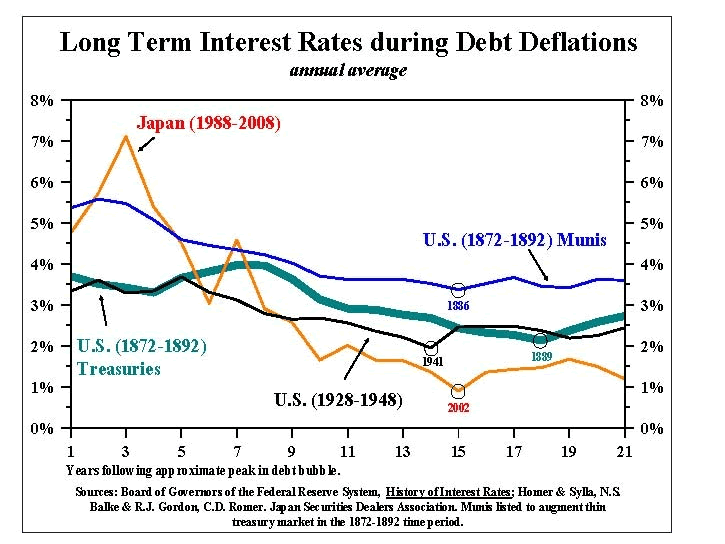
During 2008, long term Treasury bond yields fell from 4.5% to 2.7%, producing an extremely strong total return for such investments, as typified by the Wasatch-Hoisington Treasury Bond Fund (WHOSX), which returned 37.7%. Credit problems affected returns elsewhere in debt markets, limiting returns on the Barclays Capital U.S. Aggregate Bond Index (formerly the Lehman Index) to 5.2%. The decline in long Treasury yields reflected the intensification of recessionary forces as well as a collapse in inflationary expectations.
While the historical record indicates that the ultimate low in Treasury yields lies years away, the path to the ultimate low will be anything but smooth or linear as significant volatility continues. As the experience from U.S. and Japanese history indicates, many "false dawns" will occur, with investors assuming that the long-delayed cyclical recovery in economic activity is at hand. During these pleasant but relatively short interludes, stock prices will probably rise dramatically and bond yields will increase. If history is a guide, however, these episodes will further drain wealth and will be thwarted by the persistent forces of the debt deflation.
With yields in the long Treasury market very low in nominal terms, the real return will be greater if deflation sets in. Moreover, in Japan from 1988 to the present, as well as in the U.S. from 1872 to 1892 and 1928 to 1948, the total return on Treasury bonds exceeded the total return on stocks. Such a condition cannot happen for the long run, but it did happen in these three instances spanning two decades. As a hedge against a recurrence of a prolonged debt deflation, some investors may want to consider even larger positions in high quality, long term Treasury securities.
Van R. Hoisington
Lacy H. Hunt, Ph.D.
By John Mauldin
John Mauldin, Best-Selling author and recognized financial expert, is also editor of the free Thoughts From the Frontline that goes to over 1 million readers each week. For more information on John or his FREE weekly economic letter go to: http://www.frontlinethoughts.com/learnmore
To subscribe to John Mauldin's E-Letter please click here:http://www.frontlinethoughts.com/subscribe.asp
Copyright 2008 John Mauldin. All Rights Reserved
John Mauldin is president of Millennium Wave Advisors, LLC, a registered investment advisor. All material presented herein is believed to be reliable but we cannot attest to its accuracy. Investment recommendations may change and readers are urged to check with their investment counselors before making any investment decisions. Opinions expressed in these reports may change without prior notice. John Mauldin and/or the staff at Millennium Wave Advisors, LLC may or may not have investments in any funds cited above. Mauldin can be reached at 800-829-7273.
Disclaimer PAST RESULTS ARE NOT INDICATIVE OF FUTURE RESULTS. THERE IS RISK OF LOSS AS WELL AS THE OPPORTUNITY FOR GAIN WHEN INVESTING IN MANAGED FUNDS. WHEN CONSIDERING ALTERNATIVE INVESTMENTS, INCLUDING HEDGE FUNDS, YOU SHOULD CONSIDER VARIOUS RISKS INCLUDING THE FACT THAT SOME PRODUCTS: OFTEN ENGAGE IN LEVERAGING AND OTHER SPECULATIVE INVESTMENT PRACTICES THAT MAY INCREASE THE RISK OF INVESTMENT LOSS, CAN BE ILLIQUID, ARE NOT REQUIRED TO PROVIDE PERIODIC PRICING OR VALUATION INFORMATION TO INVESTORS, MAY INVOLVE COMPLEX TAX STRUCTURES AND DELAYS IN DISTRIBUTING IMPORTANT TAX INFORMATION, ARE NOT SUBJECT TO THE SAME REGULATORY REQUIREMENTS AS MUTUAL FUNDS, OFTEN CHARGE HIGH FEES, AND IN MANY CASES THE UNDERLYING INVESTMENTS ARE NOT TRANSPARENT AND ARE KNOWN ONLY TO THE INVESTMENT MANAGER.
John Mauldin Archive |
© 2005-2022 http://www.MarketOracle.co.uk - The Market Oracle is a FREE Daily Financial Markets Analysis & Forecasting online publication.


